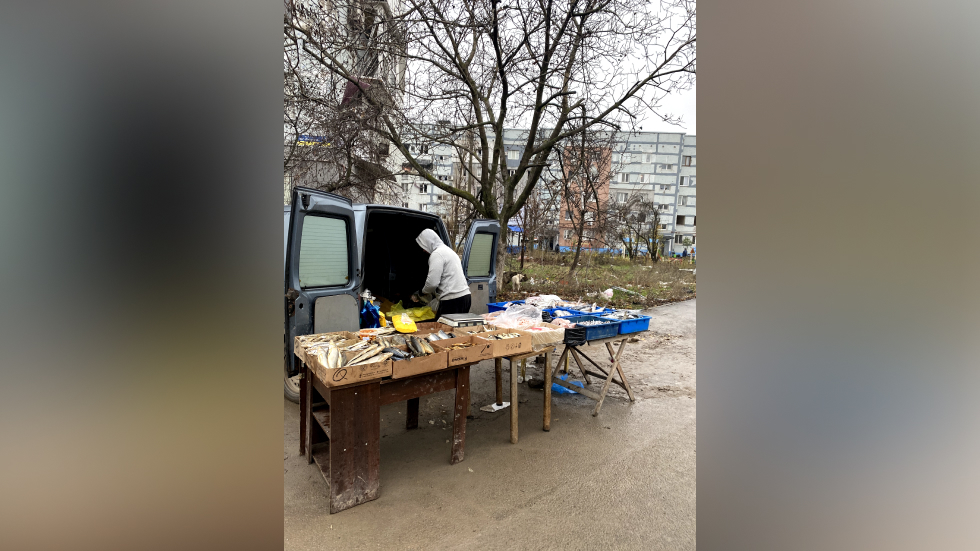‘I was nearly shot for not knowing Ukrainian’: Mariupol residents on the horrors of war and the city’s restoration

Active fighting in Mariupol began on February 24, 2022 – the first day of Russia’s military operation. It ended in late May, when the last fighters of the neo-Nazi battalion ‘Azov’, who were holding a line of defense at the Azovstal plant, finally surrendered.
In three months of fierce combat, most residential buildings were damaged or destroyed. The statistics have been confirmed by hundreds of frightening pictures of the nearly-ruined city, which were seen by the whole world. Ruined homes, broken roads, and destroyed infrastructure form a recognizable image of present-day Mariupol. And yet, thousands of people still live in the city. How do the locals feel about the war and life there today and has the city managed to recover in six months of 'peaceful' life? RT’s correspondent tried to find out.
Willpower amidst ruin
'Danger! Mines!' is one of the first road signs visible at the entrance to the city. A skull and bones are drawn under the inscription on a red plaque and below is the same text in English. Destroyed buildings sparsely appear on both sides of the highway. Some have broken windows, holes in the walls from rocket strikes, bullets, and shrapnel. Others have been leveled to the ground.

There’s a demolished depot with dozens of wrecked trams and scorched blocks of apartment buildings on the left bank. This area has suffered the most because of its location. It surrounds the Azovstal plant, and some of the fiercest fighting took place here.
Yet, oddly enough, images of destruction are not the most shocking thing about Mariupol. It hardly seems possible, but Mariupol is a city that is alive despite everything it’s been through. Many elements of civil infrastructure function as usual: Buses run on schedule, and the shops and even the bars are open.
Mariupol residents, despite the hell they’ve lived through, are going back to their usual way of life: working, walking, taking children to school, exercising pets. Shock at the horrors of war is quickly overshadowed by admiration for the strength of the locals and their will to live.

Burned houses, pet stores, and global cuisine
The rhythm of city life in Mariupol is firmly tied to the movements of the sun across the sky. At sunset, everything becomes still. The city is still poorly lit, so the view is eerie. Without waiting for curfew, residents go home. Most establishments close, and the roads become vacant. Only the icy wind scatters the debris of buildings along the empty streets. Dawn comes, and everything changes.
Markets are open all over the city. Some are quite small, about 50 meters (164 feet) long. There, the locals trade essential goods. Those who have their own small farms sell homemade eggs, meat, vegetables, and pickles. Some bake pirozhki [small buns]. Of course, there is plenty of seafood in the port city of Mariupol: fish, shrimp, crab claws, and even dried tuna. By 2pm, there are practically no goods left, and the sellers gradually pack up.

On the central streets, bigger markets stretch out up to a kilometer in length. They work until sunset. Here, you can buy clothes, including some allegedly brand name goods, rare badges, various household items, and even red caviar. In some places, you can exchange currency and buy calling cards from the local operator, Phoenix. There are usually a lot of people here. Entire families come to check out the prices and choose something to buy.
Farmers’ markets are by no means the only place to purchase essential goods. The assortment of products in Mariupol’s grocery stores and supermarkets is inferior to what can be found in a typical Russian province, but not drastically worse. In some ways, the local range of goods even exceeds the national average. For example, it is easy to find Coca-Cola cans on the shelves, even if they come from Iran.
Surprisingly, Mariupol has goods not just for people but for pets as well. It’s hard to believe that on the ground floor of a burnt-down building, you may suddenly see a working pet store with prices posted on the door. In spite of everything, people continue to buy, sell, and breed pets, and even dress them up nice and warm. And it’s little details like this that contrast so vividly with the gloomy consequences of the conflict.

Restaurants are also being actively restored. On the streets of Mariupol, you can find many shawarma shops, as well as Asian, Italian, Georgian, and other national cuisines, shops selling blini [a variety of crêpe], coffee shops, and bakeries. Some cafes even offer home delivery.
Signs of life
The food industry isn’t the only sphere of public life undergoing restoration. Destroyed bridges are being rebuilt, roads are getting repaired. New houses are constructed in place of those that cannot be restored. Buildings with minor damage are getting refurbished. New windows and radiators are put in place and connected to central heating. For now, things are going slowly. The power situation is a lot better than the heating one. Electricity is available in most public living spaces. Literally every day, the city becomes brighter, as traffic lights start functioning again in the city center.

Of course, against the background of the general destruction, the restoration work seems like a drop in the ocean. However, the fervor with which it’s done inspires optimism even among the locals. In the summer, Deputy Prime Minister of the Russian Federation Marat Khusnullin, who also oversees construction work in Mariupol, said that the city would be restored in three years. According to him, 28,000 construction workers are working hard on the task. In some places, they even help clean the leaves off the street – a strange sight in a destroyed city. However, it also comes across as a sign that things really are improving.
An orange truck is filled to the brim with leaves. A sticker on its door reads: 'From St. Petersburg to Mariupol'. On June 1, Mariupol and St. Petersburg became twin towns. The head of Russia’s northern capital promised to assist its southern brother in restoring its buildings and social services. Seeing former St. Petersburg buses, filled with passengers, traveling through the streets of Mariupol is yet another sign that the city is coming back to life.

The city’s apparent normalcy is admirable when you look around and remember what these people have been through. There are many children among the passengers on the bus. Some are being taken to school, some to kindergarten, some to a fitness center. One of the teachers at the fourth secondary school of the city of Mariupol said that life got a lot easier after the gyms and recreation centers for children reopened. After all, it is important for children to engage in after-school activities in such trying times. At the school where she teaches, children come to draw in the evenings. And in the partially-destroyed sports complex Ilyichevets, young football players regularly train.
To the surprise of an outsider, Mariupol is gradually recovering – as much as possible in such a short period of time.

“Let’s speak Ukrainian... Everyone looked around: Are they crazy?”
Valentina Markovna is 72 years old. Her apartment is located on the first floor of a five-story building where 60 families used to live. By November, only four apartments remained inhabited. The whole street was badly damaged during combat and the houses are now in disrepair.
Fortunately, new apartment buildings have been built right across the street, replacing the old ones that are about to be demolished. But there is a problem – apartments are very difficult to get because of bureaucratic delays. Beds in dormitories are offered as a temporary solution. This is hardly good news for the street’s residents.
What happened in Mariupol in the first months of the military operation can undermine almost anyone’s will to fight for justice. But not Valentina Markovna’s. She used to be the chairman of the association of co-owners of an apartment building. Under her leadership, their yard won an award for the quality of its upkeep. By the way, flowers still grow and are being cared for in the yard. Valentina Markovna planned to spend the award funds on a new variety of roses, and even managed to order them. But then the fighting began, and, suddenly, gardening had to wait.
In the new reality, her position is less formal but more significant. She is the eldest in charge of the street, and there are 32 houses under her care. This means that she tries to seek justice for all the residents of the street. She listens to each family’s problems and tries to organize help for them by contacting volunteers and talking to the new administration. She gathered the street’s residents and explained the situation with the new houses and dormitories to them. The people decided that they would stand their ground and would not live in dormitories. She cooked food for everyone who was hiding in basements during active conflict. And, even now, she still cooks soup for the neighbors and volunteers that she sheltered.

This system of 'elders' put in charge of a house or a street is well-developed in post-war Mariupol and performs several important functions. They organize mutual aid between neighbors, distribute important information, communicate with the outside world, and try to get useful resources for the community.
It’s not just the elders, however, who distribute help. Svetlana is 43 and works in a church. Along with her colleagues, she accumulates resources to hand out to the residents: food, heaters, clothes. They contact volunteers and provide help to those who need it the most. Svetlana remembers the fighting with a great deal of pain. She talks about how she personally tried to stop the shelling of a residential building by a Ukrainian Armed Forces tank and how she was briefly told “an order is an order.” She also remembers how the whole district rejoiced, turned on the Russian national anthem, and cried when the Russian army entered the city.
This is probably the most difficult thing about talking to Mariupol residents. No matter how cheerful a person may seem in the first few minutes, the conversation naturally goes back to what happened six months ago. Most people have tears in their eyes. They remember their dead loved ones and destroyed homes. They remember how they hid in basements. Many people talk about the cruelty of the Azov regiment.
“I almost got shot because I don't know the Ukrainian language. The only thing that saved us was that the Azov army got under fire and ran away,” says Arsen, a Russian Armenian from Surgut. Twenty years ago, he moved to Mariupol to be with his mother and met the love of his life there. His girlfriend talks about how her friend tried to remove her mother’s body from the road but was shot by a Ukrainian female sniper. There are hundreds of stories like this one.

Vitalik, a native of Mariupol, also commented on the language issue. He is 31 years old, works as a driver, and helps volunteer organizations. Vitalik says: “In former times, we used to mess around. We’d gather with friends and go for a walk in the city center. As a joke, we'd start speaking Ukrainian, and everyone looked around and thought: Are they crazy?”
In spite of all the horror they’ve experienced, many people remain optimistic about the future. They count on Russia for help and expect life to get better.
At this point, Mariupol may be best described by the adage, “Things aren’t that straightforward.” A significant part of the city has been destroyed, yet it’s teeming with life. Recovery is in full swing, but it’s not fast enough. People are busy with their everyday lives, but the mental and physical wounds of battle are still too deep to forget.
Mariupol’s citizens are undoubtedly extremely strong people who’ve lived through hell. Despite all their losses and pain, they are persistently rebuilding their lives.
The names of some people have been changed for safety reasons.















